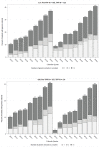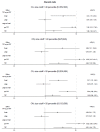The Impact of Tiered-Pricing Framework on Generic Entry in Canada
- PMID: 33233033
- PMCID: PMC9309918
- DOI: 10.34172/ijhpm.2020.215
The Impact of Tiered-Pricing Framework on Generic Entry in Canada
Abstract
Background: Generic drug prices have been capped at specified percentages of the interchangeable branded drug's price by the Canadian provincial public drug plans since 1993. The Pan-Canadian Pharmaceutical Alliance, formed as a coalition by the provinces/territories in Canada, implemented an alternative approach, a tiered-pricing framework (TPF) for new generic drugs on April 1, 2014, under which the percentage varies with the number of generic firms in each market. We evaluate the impact of the TPF on generic entry, ie, listing in public drug plans in Canada.
Methods: Our study compared the pre-TPF period (01/01/2012-03/31/2014) with the TPF period (04/01/2014- 06/30/2016). Prescription drugs from nine provincial public drug plans were grouped into a "market" if they had the same active ingredient and strength, route of administration, and dosage form. Each "market" was contestable by generics and met the eligibility criteria for TPF. At the "market" level, Cox proportional-hazards models with time-varying covariates were used to measure the impact of the TPF on the first generic listing in any provincial public drug plan in Canada relative to the first launch date worldwide.
Results: A total of 189 markets in Canada were selected for the analyses. Generic drugs in small markets were more likely to be listed in Canada during the TPF period compared to the pre-TPF period (hazard ratio [HR], 95% CI: 3.81, 1.51-9.62). There was no significant difference in generic drug listings in large markets between the two policy periods.
Conclusion: TPF speeds up generic entry in small markets and generates the benefits of generic competition while avoiding the pitfalls of the previously employed price-cap regulations.
Keywords: Canada; Generic Drug; Generic Entry; Price-Cap Regulation; Tiered-Pricing Framework.
© 2022 The Author(s); Published by Kerman University of Medical Sciences This is an open-access article distributed under the terms of the Creative Commons Attribution License (http://creativecommons.org/licenses/by/4.0), which permits unrestricted use, distribution, and reproduction in any medium, provided the original work is properly cited.
Similar articles
-
The pan-Canadian Tiered Pricing Framework and Chinese National Volume-Based Procurement: A comparative study using Donabedian's structure-process-outcome framework.J Glob Health. 2023 Nov 10;13:04137. doi: 10.7189/jogh.13.04137. J Glob Health. 2023. PMID: 37947028 Free PMC article.
-
The impact of price-cap regulations on market entry by generic pharmaceutical firms.Expert Rev Pharmacoecon Outcomes Res. 2017 Apr;17(2):231-238. doi: 10.1080/14737167.2017.1271717. Epub 2016 Dec 27. Expert Rev Pharmacoecon Outcomes Res. 2017. PMID: 27936981
-
The Impact of Price-cap Regulations on Exit by Generic Pharmaceutical Firms.Med Care. 2016 Sep;54(9):884-90. doi: 10.1097/MLR.0000000000000577. Med Care. 2016. PMID: 27213540
-
Impact of European pharmaceutical price regulation on generic price competition: a review.Pharmacoeconomics. 2010;28(8):649-63. doi: 10.2165/11535360-000000000-00000. Pharmacoeconomics. 2010. PMID: 20515079 Review.
-
Effects of reference pricing in pharmaceutical markets: a review.Pharmacoeconomics. 2011 Jan;29(1):17-33. doi: 10.2165/11537860-000000000-00000. Pharmacoeconomics. 2011. PMID: 21142276 Review.
Cited by
-
The pan-Canadian Tiered Pricing Framework and Chinese National Volume-Based Procurement: A comparative study using Donabedian's structure-process-outcome framework.J Glob Health. 2023 Nov 10;13:04137. doi: 10.7189/jogh.13.04137. J Glob Health. 2023. PMID: 37947028 Free PMC article.
-
The Impact of Suboxone's Market Exclusivity on Cost of Opioid Use Disorder Treatment.Appl Health Econ Health Policy. 2023 May;21(3):501-510. doi: 10.1007/s40258-022-00787-0. Epub 2023 Jan 18. Appl Health Econ Health Policy. 2023. PMID: 36652186 Free PMC article.
-
The impact of proposed price regulations on new patented medicine launches in Canada: a retrospective cohort study.CMAJ. 2024 May 26;196(20):E691-E701. doi: 10.1503/cmaj.231485. CMAJ. 2024. PMID: 38802136 Free PMC article.
-
The association between drug pricing and drug shortage in Saudi Arabia: a retrospective database analysis.J Pharm Policy Pract. 2023 Jul 18;16(1):91. doi: 10.1186/s40545-023-00591-8. J Pharm Policy Pract. 2023. PMID: 37464406 Free PMC article.
-
Market Exclusivity of the Originator Drugs in South Korea: A Retrospective Cohort Study.Front Public Health. 2021 Apr 6;9:654952. doi: 10.3389/fpubh.2021.654952. eCollection 2021. Front Public Health. 2021. PMID: 33889560 Free PMC article.
References
-
- Canadian Institute for Health Information (CIHI). Prescribed Drug Spending in Canada, 2018: A Focus on Public Drug Programs. Ottawa: CIHI; 2018.
-
- Douglas K, Jutras C. Patent Protection for Pharmaceutical Products in Canada: Chronology of Significant Events. Ottawa: Parliament of Canada; 2008.
-
- Government of Canada FAT and DC. United States-Mexico-Canada Agreement (USMCA) - Intellectual property chapter summary. GAC. http://international.gc.ca/trade-commerce/trade-agreements-accords-comme.... Accessed October 24, 2018.
MeSH terms
Substances
LinkOut - more resources
Full Text Sources
Miscellaneous




